(RETURN)
SAIL VOLUME II
II. PASSENGER AND EMIGRANT CLIPPER SHIPS
MALBOROUGH
(1846 - 1869), 1,402 registered tons, length 175ft
5in, beam 41ft 5in, depth 29ft 1in.
Costructed of
wood at T.W.
Smith's Tyne yard for
T.W. Smith's shipping service to India. An early
Blackwall
frigate. She
was built for easy conversion to a fifty gun naval frigate
with scantlings pierced for gun
ports. The
Blackwall frigates built by
Smith, Green (Blackwall Line) and Wigram were 500 tons larger
than
the London
passenger ships of their day. MALBOROUGH entered
the Indian trade carrying passengers
and troops to
Calcutta and
Madras. In1854, she made one voyage to Australia because of the
press of
passengers in
the Gold Rush. She carried 325 passengers and
reached Melbourne in 78 days from the
Lizard.
Her return journey
via Cape Horn was also a creditable 83 days. In 1869.
she was withdrawn from
service and
converted to a coal hulk at
Gibraltar.
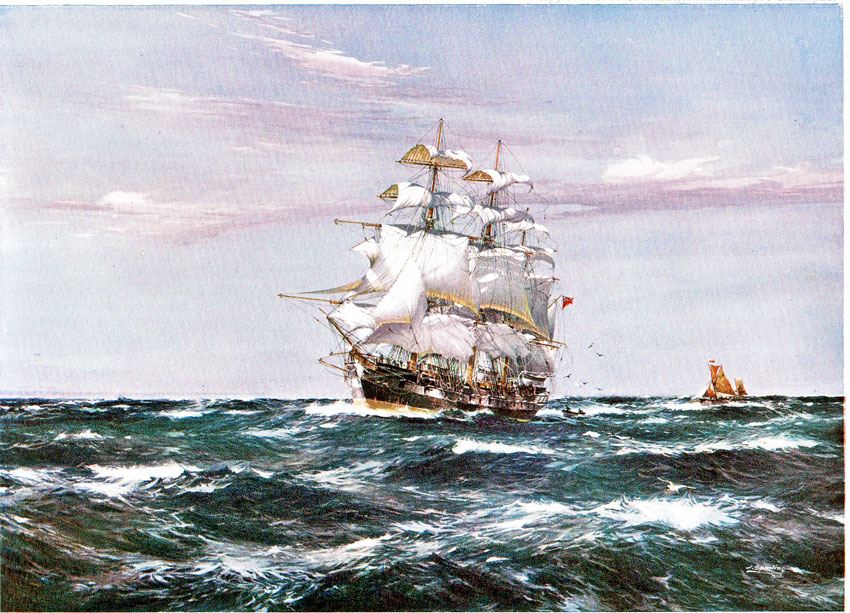
BENVENUE
(1867 -1882), 999 registered tons, length 210ft, beam 35ft 1in,
depth 20ft 7in. Consructed
of iron, built
by Barclay, Curle,
Glasgow for Watson Bros. In her early years she
was entirely in the
Melbourne
trade. In 1876, she was transferred to
the New
Zealand trade. She made
the very fine average
of 77days for
her outward passages to New
Zealand. She made six voyages to New Zealand. In 1882 on
her
sixth voyage, she was driven ashore when her anchors dragged during a
gale at Timaru and she became
a total
loss.
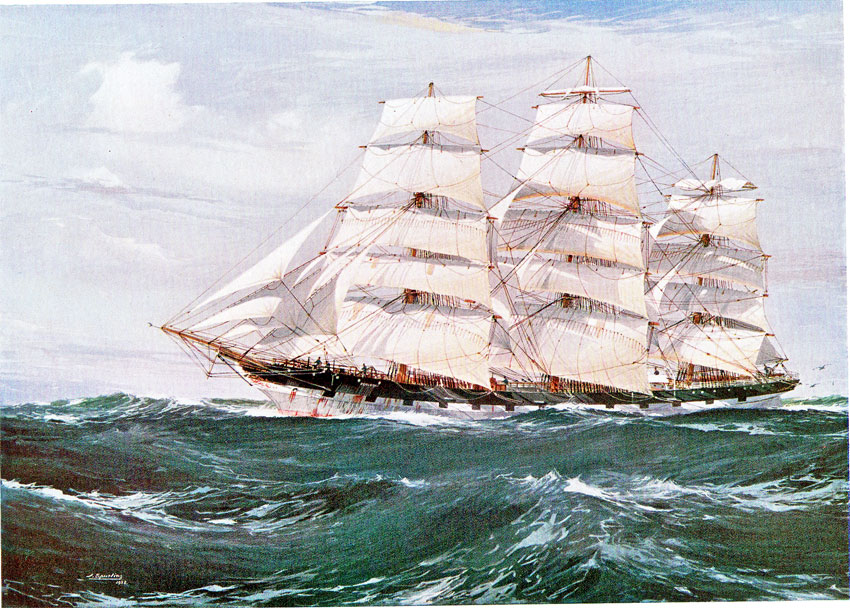
THOMAS STEPHENS
(1869 - 1916) 1507 registered tons, length 263ft, beam 38ft 2in, depth
23ft 1in.
Contructed
of iron, built by Potter,
Liverpool, as passeenger ship for the Black Ball Line but the Line
collapsed
before she was launched. On completion she sailed under the
Bethell & Co.'s London line of
Australian
packets and was owned by
Thomas Stephens & Sons, London. In the 1870's, she was one of
the
crack ships in the Australian passenger trade. In the 1870's, her
passages to Melbourne were between
66-78 days.
In the !880's and 90's.she
was kept regularly in the Australian trade except for an occasional
run
to San Francisco, Calcutta and Rangoon. In 1896, she was sold to the
Portuguese Government,
renamed PERO
d'ALEMGUER, and became a training
ship. In 1914, she was lying as a hulk in the River
Tagus. In
1915, she was refitted and sent to the United States.
On her return journey in 1916 she was
posted as
missing..
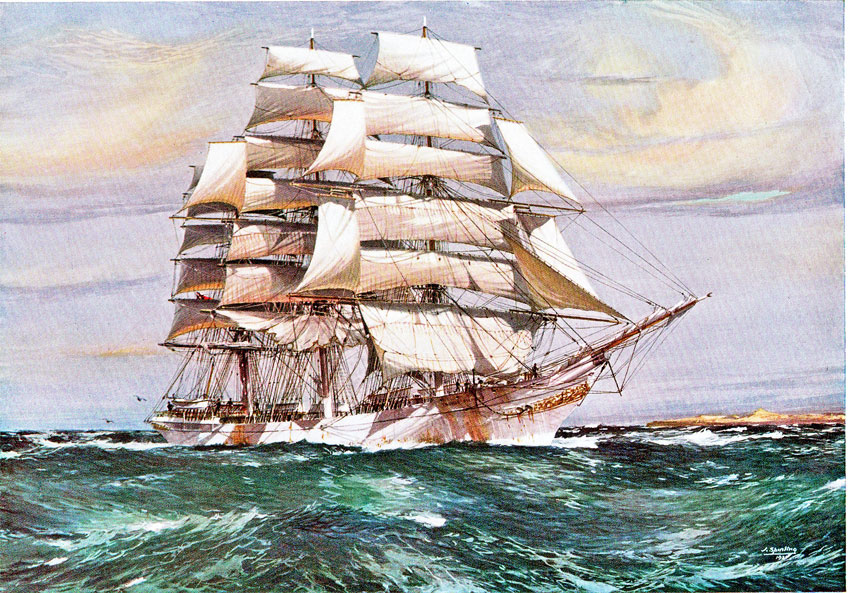
PATRIARCH
(1869 - 1912), tonnage 1,405 gross and 1,339 net, length 221ft 1in,
beam 38ft 1in,
depth 22ft 3in.
Constructed of iron, built by Hood, Aberdeen,
for George Thompson's Aberdeen
White Star
Line. Though fine lined and
fast she had the reputation of being a very dry ship.
Basil
Lubbock
comments that "it was owing to her splendid
seaworthiness that, in twenty-nine years of
racing out and
home, she
never had a
serious accident and never came on the overdue list" She was
on
the Sydney run for most of her twenty nine years career with Aberdeen
White Star. On her
maiden voyage
in 1870, she established a record for iron ships by arriving in
Sydney
('pilot to pilot')
in 67
days. In 1898, she
was sold to Norwegian owners.. In
1912, she was wrecked when she
came ashore
south of the River Plate on the Argentinian coast and was a total loss.
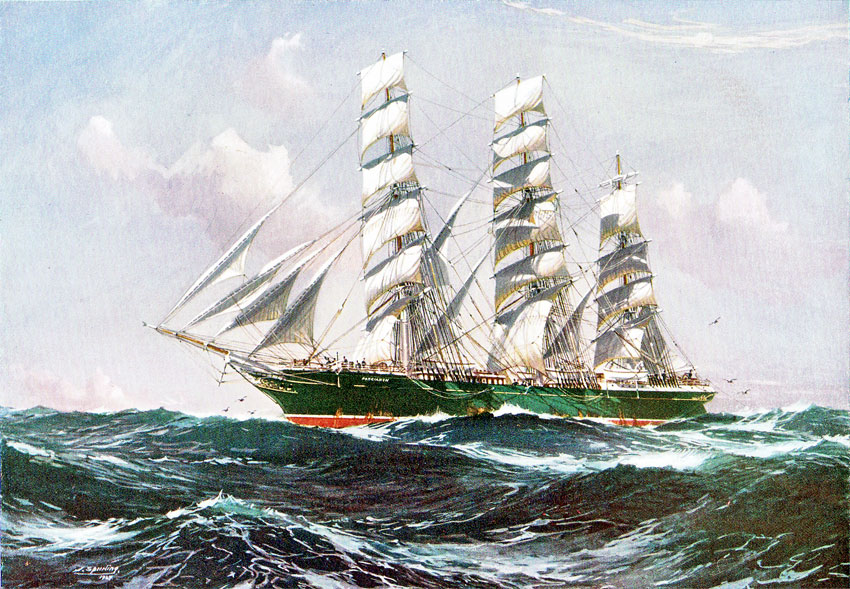
MILTIADES
(1871 - 1905), 1452 registered tons, length 240ft 5in, beam 39ft
1in, depth 23ft 3in.
Of iron
construgtion, built by Hood, Aberdeen, as a passenger ship for George
Thompson's Aberdeen
White Star
Line. Thompson's second iron ship.
She was built for the carriage
of emigrants and put on
the
Melbourne run. Unlike PATRIARCH she
was a wet ship but faster. her best outward passage was
in 1873 -
66 days
pilot to pilot and 70 days dock to dock. In 1874, she was sent to
Auckland with
470 emigrants.
From 1890, she was transferred to
the Sydney run but was not as regular in getting a
wool cargo for
the
return voyage. In 1890, she went from Sydney to Lyttelton to get a
cargo, and again
in 1891.to
Wellington for the
same purpose.. In 1896-97, she crossed the pacific to San
Francisco for
a return cargo.
She was sold to Italian owners in 1901 and broken up in 1905.
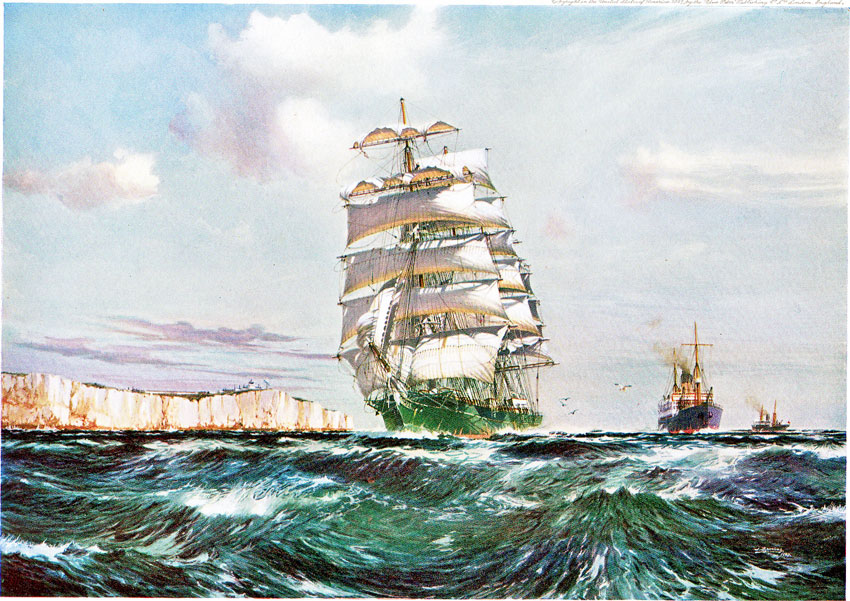
BEN VOIRLICH
(1873 - 1918), 1,474 registered tons, length 255ft 6in, beam
37ft 1in, depth 28ft 8in.
Constructed of
iron, built by Barclay, Curle
, Glasgow, for Watson Bros. In the Melbourne trade , she
carried
passengers (saloon, second cabin and steerage) out and wool on the
return voyage. In 1875, in
her second
voyage, her outward passage to
Melbourne was 64 days to Port Phillip from Plymouth. She
was
transferred to the Sydney trade in 1886 and in 1887 to the San
Francisco grain trade.She was sold
to German
owners in 1891and
converted to a barque. In 1903, she was sold to Italian owners
and
renamed
COGNATI. Towards the end of World War I she was at Leith where
she was converted into
an
accommodation hulk for the crews of surrendered German ships.
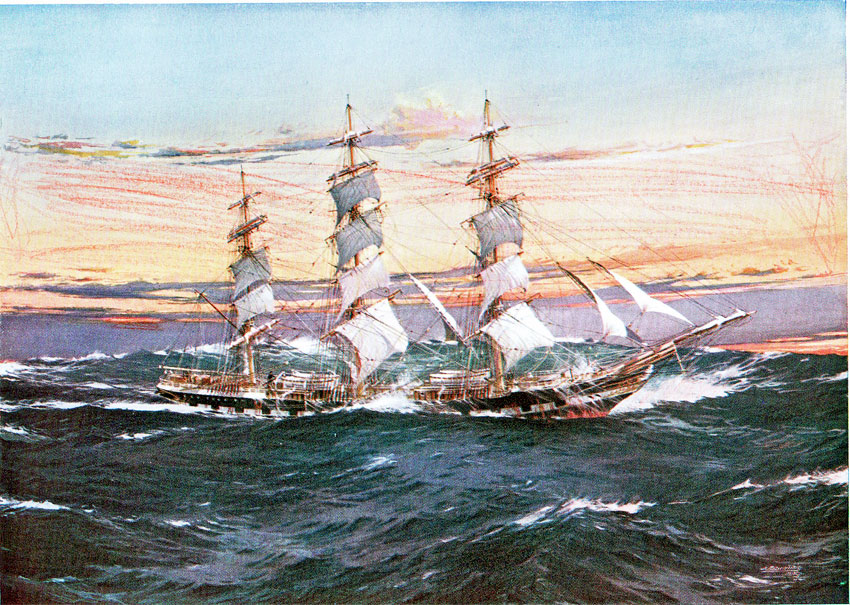
SAMUEL PLIMSOLL
(1873 - ), 1,444 registered tons, length 241ft 3in,beam 39ft,
depth 23ft 1in.
Of iron
construction, built by Hood, Aberdeen,
for Georg Thompson's Aberdeen White Star Line.
Thompson's
third
iron clipper and was built to carry emigrants. She was in the Sydney
trade until 1887
when she was
transferred to the
Melbourne trade.. She was fast and on her
maiden voyage in 1874,
was 74
days form Plymouth to Sydney - the fastest passage by any ship in that
year. In 1899 she
caught fire in
the Thames and was scuttled.. After being raised and repaired she was
sold to Shaw
Savill &
Albion Co.who ran her in the New
Zealand trade until in 1902she was
dismasted in a voyage to
New Zealand and
towed by a steamship to Port
Chalmers. She was subsequently towed to Sydney and
ended up as a
coal hulk
in Fremantle, Western Australia.
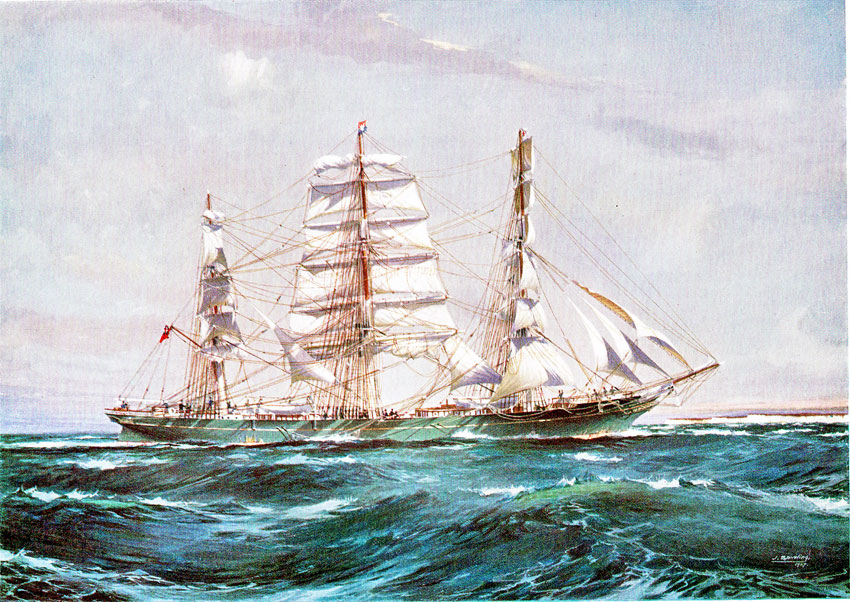
RODNEY (1874
- 1901), tonnage 1,519 gross and 1,447 net,, length 235ft 6in, beam
38ft 4in,
depth 22ft 6in.
Constructed of iron, built by W.Pile &
Co., Sunderland, for Devitt & Moore.
She was
designed to
carry first-class passengers with accommodation considered
luxurious at
the time.
Her owners regarded her as their fastest ship. In 1880
she made a passage to Adelaide
in 74 days out.
Her best passage to
Melbourne was in 1882 - 69 days from the Channel. In
1887, she
reached Sydney from the Lizard in 77 days matching the record set by
PATRIARCH
in 1870. She
was in the Melbourne trade until 1887 with the
exception of the voyage to Adelaide
in 1880..
Then she was in
the Sydney trade until 1897. She was sold to French owners in
that
year and
renamed GYPSY. In 1901, she
was wrecked on
the Cornish coast with a cargo of
nitrates from
Iquique, Chile . .
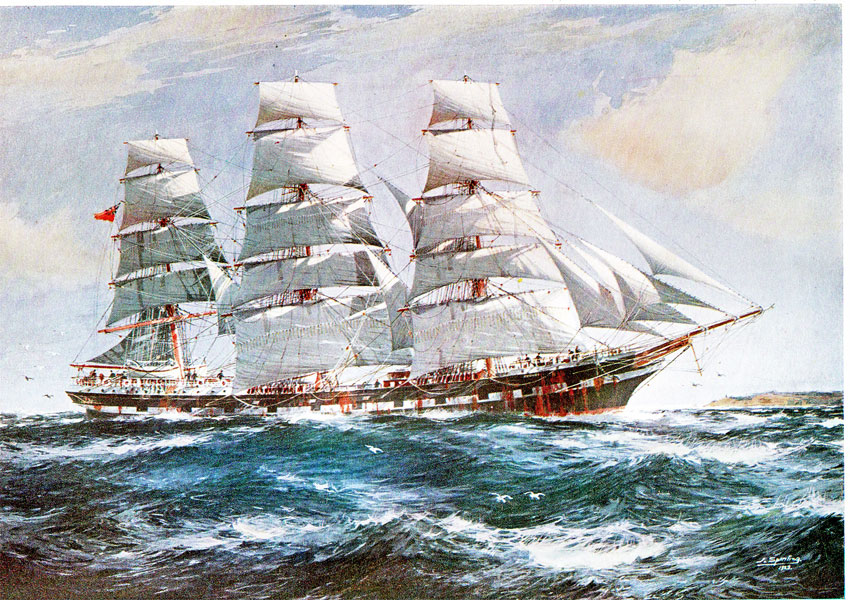
INVERCARGILL
(1874 -1905), 1,246 registered tons, length 239ft 7in, beam 36
ft, depth 20ft 7in.
Constructed of
iron , built b Robert Duncan,
Glasgow, for James Galbraith of the Albion Line. One of
six Albion Line
sister ships in the New Zealand trade. In 1874, her maiden voyage with
390 passengers
to Port
Chalmers, New Zealand, was in 90 days. She made altogether 26 passages
to New Zealand -
14 to Port
Chalmers, 7 to Wellington 2 to Lyttelton, 2 to Timaru and 1 to
Auckland. The average passage
time for the 26
voyages was 89.38
days. In 1904, she had a bad passage home when she broached and
was put on her
beams end off Cape Horn. The cargo shifted and it was
only by a herculean effort that
the ship was
righted.after a day and a
night with her lee dipping six feet into the sea.. She made
Queenstown
(Cobh), Ireland, 113 days from Sydney. She was towed to Glasgow
for repair and sold to
Norwegian
owners. She left the Clyde in
February 1905 for Christiana to pick up a cargo of timber for
Melbourne.
She was posted missing on this voyage.
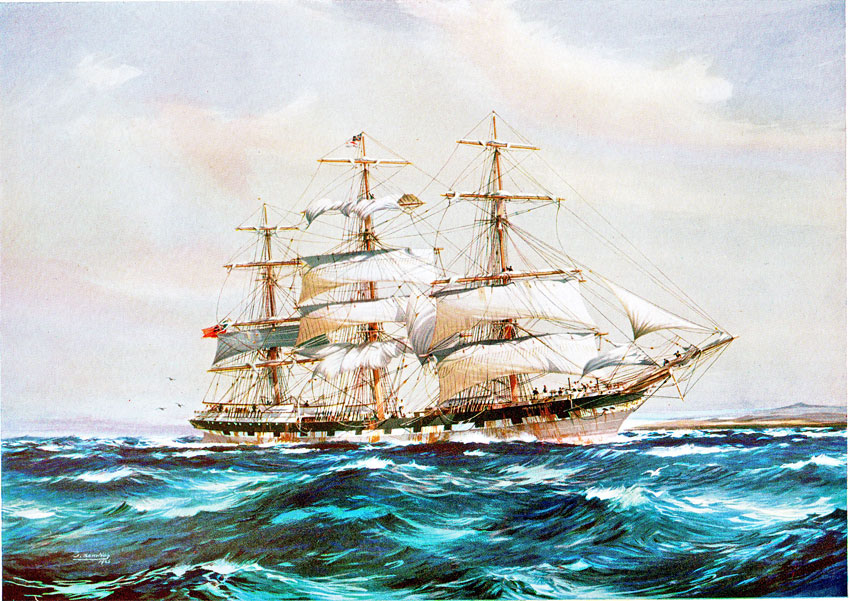
WAIMATE
(1874 - 1899), tonnage 1,156 gross and 1,124 net, length 219ft 7in,
beam 35ft 1in,
depth 20ft 7in.
Constructed of iron, built by J. Bumer
& Co., Sunderland, for the New Zealand
Shipping Co.
She could
carry 300 to 400 emigrants She made 22 voyages to New Zealand -
10 to
Lyttelton, 8 to Port Chalmers, 3 to
Auckland and 1 to Wellington. The average for all the
outward
passages was 92.14 days - to Lyttelton
90.5 days and Port Chalmers 91 days. The
fastest
outward
passage was 74 days to Lyttelton in 1880. She came close
to destruction in her
return
passage around
Cape Horn in 1881 when she dropped both anchors and they held when
she was
being driven towards the rocks. In
1896, she was sold to Russian owners and was
renamed
VALKYRIAN. In 1899
she sailed with a cargo of coal from Necastle, N.S.W. to
Iquique.
Chile, and was never heard of again.
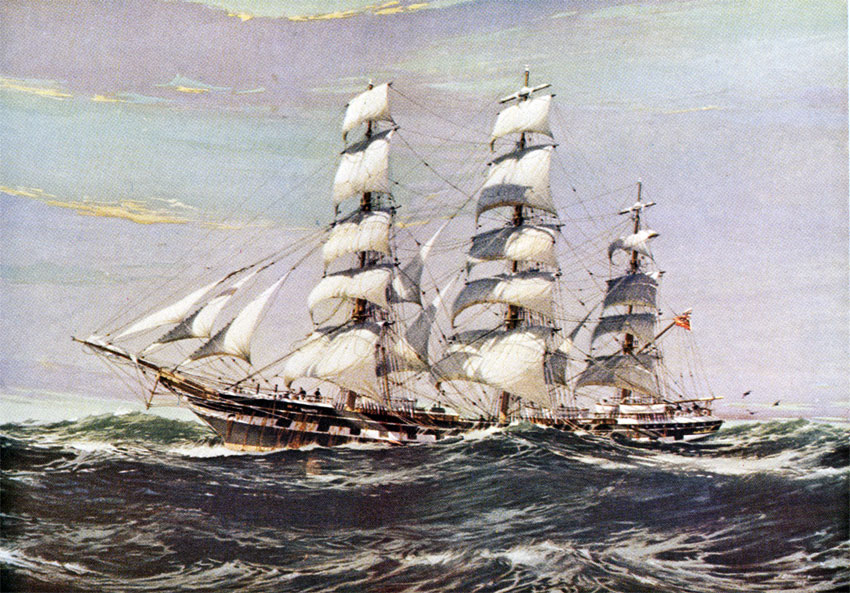
DUNTRUNE
(1875 - 1899), tonnage 1,561 gross and 1,488 net, length 245ft 2in,
beam 38ft 3in,
depth 23ft 1in.
Constructed of iron, built by
Alexander Stephen & Sons, Dundee, for
David Bruce's
Dundee Clipper
Line. In her early years she was in the
Australian trade and usually sailing from London
or the Clyde in
November. In a voyage to Brisbane, Queensland, in 1883 she carried 448
assisted
emigrants. On
this voyage,
the condenser broke down and the
vessel was forced to put in to Madeira
for repairs and
to get fresh water.
After delivering her emigrants she
carried coal to San Francisco
and
wheat from there to England. In 1896, David Bruce & co.
decided to sell all their ships.
DUNTRUNE was
purchased by a
Belfast firm. In 1899 the vessel was
dismasted west of Cape
Horn and the
Captain died that same night.
The ship ran in
to the coast under jury rig and anchored
off a lee
shore. A boat under the ship's carpenter set off to get help lost
its way but was picked up
after 17 days
by a sealing
schooner. The survivors were landed and a Chilean gunboat went in
search of the
DUNTRUNE but couldn't
find her and she was posted as missing.
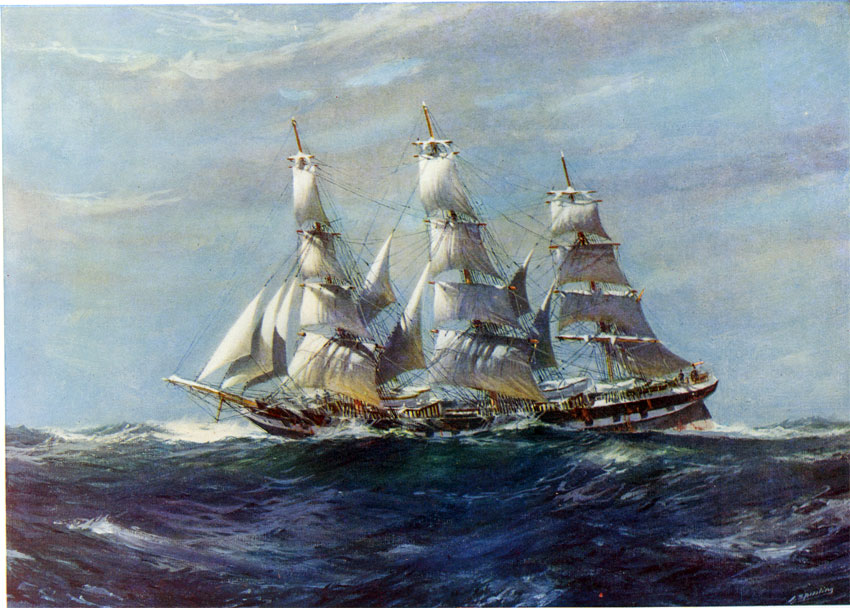
TORRENS
(1875 -1910), tonnage 1,335 gross and 1,276 net, length 222ft 1in, beam
38ft 1in,
depth 21ft
5in. Of composite (iron frame planked with
teak) construction, built by James Laing ,
Sutherland, for Captain H.R Angel who was a part owner with the
Elder
Line and commanded
her for
fifteen
voyages from 1875 to 1889. She was a good sea boat and a
relatively dry one.
She was at
her best however ghosting through the tropics. On her return
journeys she came by
the Cape
of Good Hope, St Helena and Ascension Is.
for passenger comfort. For
years she was
the
favourite passenger ship on the London to Adelaide
run. She established the record of 74
days
for the passage between
Plymouth and Adelaide. In 1905 she was sold to Italian owners
and
after a grounding in 1910 was sent to the ship breakers.
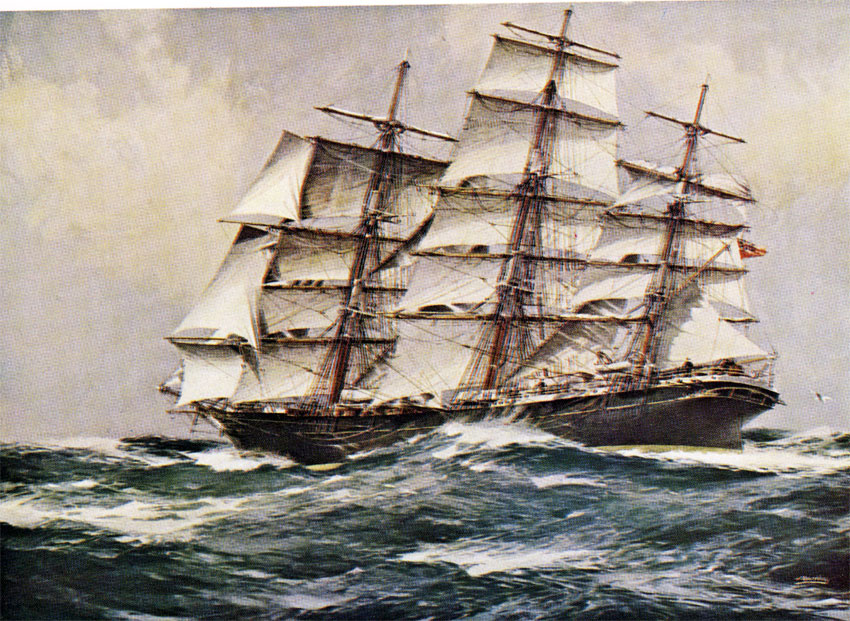
PIAKO (1876
- 1900), 1,075 registered tons, length 215ft 3in, beam 34ft, depth 20ft
5in. Of iron
construction,
built by Alexander Stephen,Glasgow, for
the New Zealand Shipping Co. Piako made
17 voyages to
New Zealand
- 6 to Auckland, 4 to Lyttelton, 4 to Port Chalmers and 3 to
Wellington.
Her average
passage time for 16 of these voyages was
95.38 days. Her second voyage where she
had to put into
Pernambuco for
repairs because of a fire in her cargo lasted 145 days is not counted
in the average.
In 1900, carrying supplies to the Cape from
Melbourne for the troop in the Boer
War, PIAKO
was
posted as missing
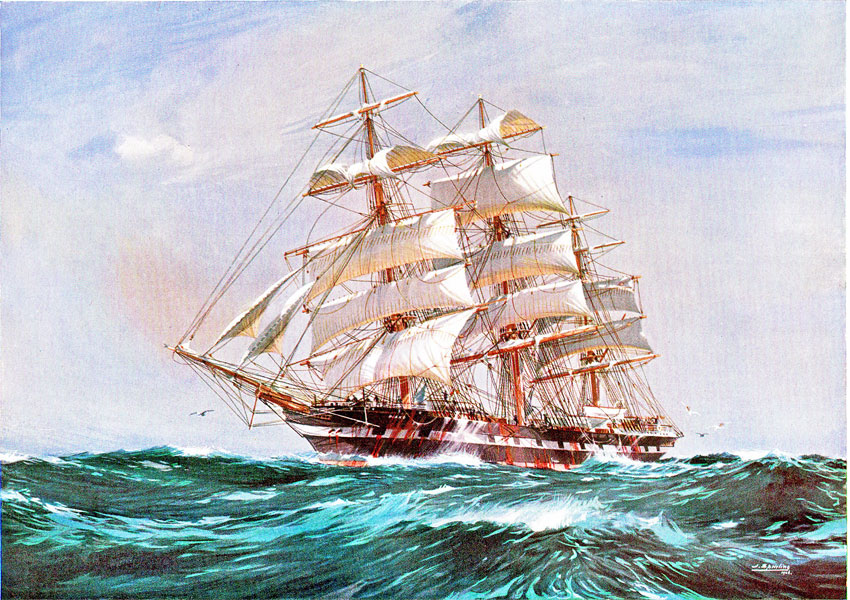
ARISTIDES
(1876 - 1903), 1,661 registered tons, length 260ft, beam 39ft 5in,
depth 24ft 5in.
Constructed of
iron, built by Hood, Aberdeen for
George Thompson & Co.'s Aberdeen White
Star Line.
Built as a
passenger clipper flagship of the company's fleet. Her maiden
voyage in 1876
from London to
Melbourne was an unsuccessful attempt to
beat the record. She reached
Melbourne 74
days out and her return
journey was 81 days. She was kept on the Melbourne run
until 1889
when she was switched to the Sydney trade. She mostly had a
full passenger list in both
Melbourne and
Sydney. In 1897, after
Lloyds had raised its insurance rates for sailing ships,
Aberdeen White
Star sold its sailing ships except for ARISTIDES. In her last
years, she was
seeking cargoes
wherever they could be found. In 1903
she sailed from Caleta Buena, Chile, with
a cargo of
nitrate of
soda, for San Francisco and was posted as missing.
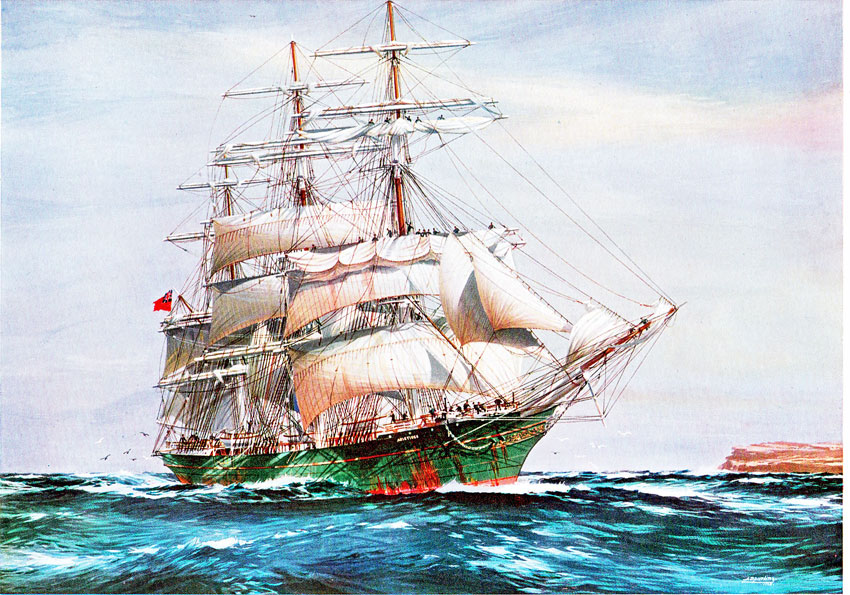
RETURN













